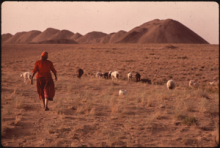Article
There is a long standing tradition of sheep and cattle herding among the Navajo and Hopi, as well as other Native peoples in the New Mexico and Arizona area. In warm weather, livestock is often taken to graze some distance from villages, to areas usually higher in elevation that offer abundant forage vegetation. Summer herding camps are temporary base settlements that can consist of tents or simply blankets laid on the ground next to a fire ring, although if the camp is used consistently by the same family, more permanent structures can also be also constructed. Water and food supplies are kept in the camp, so that herders can take the sheep out to graze during the day and come back by evening to spend the night at the camp. Sheep or cattle owners are often accompanied by their families, so that young boys can learn herding skills. Women and girls usually stay at the camp to cook and engage in craft making such as weaving. These seasonal herding camps are often located in remote areas, and are reached by wagon or a pickup truck that can traverse a rough terrain where no established roads are present.
"Navajo sheepherding on the Navajo Reservation in Utah, May 1972" by Terry Eiler is licensed under Public Domain.
Manuscripts
References
Beaglehole, Ernest, and Pearl Beaglehole
1937 Notes On Hopi Economic Life. New Haven: Yale University Press.
Landgraf, John Leslie
1950 Land Use in The Ramah Navaho Area, New Mexico. New York: Columbia University
Department of Anthropology.

